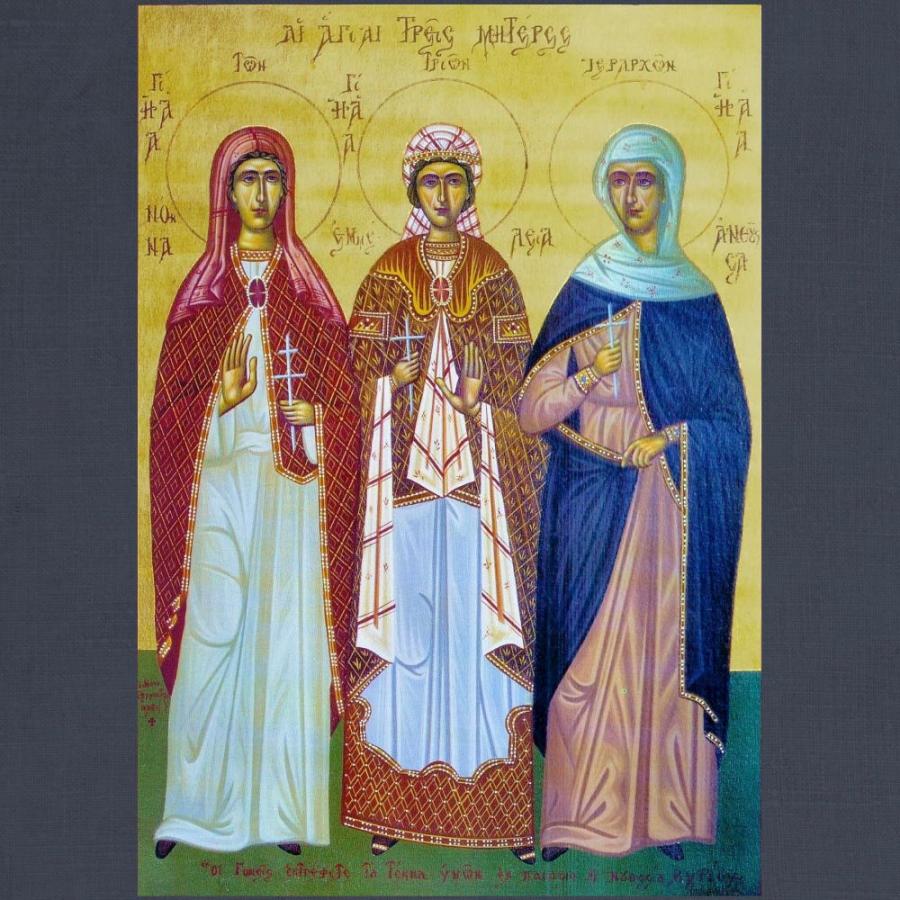
The Three Holy Mothers of the Three Hierarchs: Sts. Nonna, Emmelia, and Anthousa are commemorated on the Sunday after the Feast of the Presentation of Christ to the Temple
In Greece, the feast of the Presentation of Christ to the Temple has become the celebration of Mother's Day, as the feast honors the Theotokos. Because January is also the month in which we celebrate the Three Great Hierarchs and Ecumenical Teachers (Sts. Basil the Great, Gregory the Theologian, and John Chrysostom), the Sunday after the Feast of the Presentation of Christ has become the common feast of their mothers, Sts. Nonna, Emmelia, and Anthousa. These women not only inspired some of our greatest teachers of the faith, but they, too, lived lives worthy of remembrance and imitation.
St. Nonna, the mother of St Gregory, refused to let the difficult circumstances of her life define her. Raised in a Christian home but married to a wealthy pagan landowner, for years St. Nonna prayed for her husband to come to faith. One night he had a vision in which he was singing the Psalms, and decided to be baptized. Years later, St Nonna was ordained a deaconess at the same time that her husband was consecrated a bishop. From then on she occupied herself in performing works of generosity and charity, even amidst the personal tragedy of losing several children. She died in old age while at prayer in the temple on August 5, 374.
St. Emmelia, the mother of St. Basil the Great, was actually the mother of ten children, five of whom were later numbered among the saints. After raising her children in the faith, she later founded a monastery for women with her daughter, St. Macrina the Younger. From then on, she lived the rest of her life as a monastic and in great generosity. As the daughter of a martyr and the daughter-in-law of St. Macrina the Elder, St. Emmelia held a unique place of influence in a long line of holy women.
St. Anthousa was a highly educated and well-off woman living in the city of Antioch in the fourth century and married to an illustrious officer in the Imperial Army of Syria. Together, they had a son named John. While he was an infant, Anthousa’s husband died, leaving her widowed when she was only about twenty years old. After this, Anthousa devoted her life to her son, instilling in him an intimate knowledge of the Scriptures and teaching him much of her classical knowledge. While John did later study under great men of his time period, the spiritual knowledge and applications found in his great homilies owe much to his mother’s early teachings.
Each of these women lived very different lives, yet all are bound together by the way their lives inspired the holiness and God-ward pursuit of their children. By their lives, simple or obscure as they may have felt to the women themselves, they directed their families towards goodness, curiosity, excellence, and love. Together, these three saints remind us that–biological mothers or not–we can have an enormous impact as spiritual mothers in the life we live and the legacy we hand down to those in our care.
Holy Mothers Nonna, Emilia, and Anthousa, pray to God for us!
—-
Prosomoia of the Stichera in the Plagal of the Fourth Tone.
What shall we call you, O Saints?
What shall we say of you, O Emmelia? The child-loving mother of wondrous children, the tender-loving woman of sacred works, for you bore the Great Basil, and also nursed Peter and Navkration, the bearer of Gregory of Nyssa, and Makrina who was enlightened by God, intercede, that our souls be saved.
How shall we call you, O divine Nonna? A mother of fervant prayer, like that of the Prophet Samuel, the sweetest spouse, as proclaimed by Gabriel? You sprouted the all-wise Gregory, and you watered Caesarios and Gorgonia with the springs of piety, and the waters of the faith, intercede, that our souls be saved.
How shall we now hymn Anthousa? As the spouse of Sekoundos, the Christian leader, the mother of John Chrysostom the wise. As a pillar of wisdom and chastity, and an example of motherly purity, fragrant flower of love, and unfading crown of glory, intercede, that our souls be saved.
Apolytikion of the Saints in the First Tone. The Three Great Lights.
The three Holy Mothers of the Teachers let us honor, who bore the Hierarchs, and preached Christ, and watered them with the milk of piety, and nurtured them on the glorious faith, training them as trees. Emmelia the divine, and Nonna the thrice-blessed, and the chaste Anthousa, the astonishment of Lebanon. Come, the imitators of their struggles, let us gather together to offer hymns to them, as they intercede for us to the Trinity.
Oikos
Behold now, the light-bearing day has dawned of the divine memory our Venerable Mothers. Come, you of godly mind, rejoice now, and hasten to honor them as is right with godly hymns, imitating their incomprehensible way of life, and their God-pleasing manner, and their virtues and struggles, their pains and sweats, for their entreated God with prayer, and supplication, and humility, and love, patience and chastity, and with every other virtue, especially chastity and brotherly love. Therefore, with fervor let us cry out: Rejoice Emmelia, together with divine Nonna, and all-praised Anthousa.


